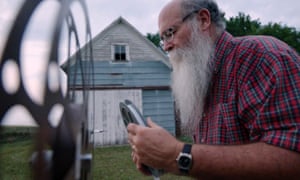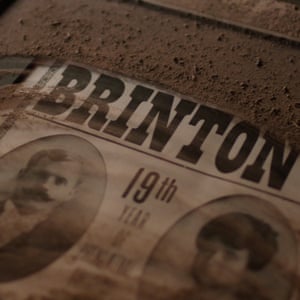https://www.theguardian.com/film/2018/jun/22/how-did-some-of-cinemas-greatest-films-end-up-in-an-iowa-shed
How did some of cinema’s greatest films end up in an Iowa shed?
A heartwarming new documentary tells the story of the history teacher who stumbled upon the Brinton Collection, a unique archive of films from the earliest days of moving pictures

Michael Zahs thinks of himself as a saver. “I like to save things,” he says, “especially if it looks like they’re too far gone.” This retired history teacher from Iowa, now in his 70s, has amassed quite a collection over the years: stray animals, farm implements, even a church steeple. He can trace the lineage of the peach trees in his yard back to 1800. Nothing he has saved, however, has been quite as remarkable as the Brinton Collection – a mammoth set of films, lantern slides, posters and projection equipment from the first years of cinema, and even earlier. There are two exciting things about these artefacts. One is that during the more than three decades after Zahs took delivery of the collection and stored it on his property, he has been showing its treasures to local people and keeping the tradition of the travelling showman alive. The second is the discovery that the collection contains very rare material – films by the French cinema pioneer, George Méliès that were once thought to be lost.
Saving Brinton, an absorbing new documentary by Andrew Sherburne and Tommy Haines, tells the story of Zahs and the collection he saved. Between 1895 and 1909,one Frank Brinton crossed the Midwest with his wife Indiana and his travelling show, welcoming locals for a ticket price of just a few cents. At first he showed magic lantern slides, some of which “dissolved” between two static images to create an illusion of movement. When moving pictures arrived, Brinton jumped aboard, ordering many films from distributors in France, one of the most prolific and creative producers in the early period. He also became the manager of the Graham Opera House in Washington, Iowa, which is now known as the State Theater and has been certified by Guinness World Records as the oldest continuously operated cinema in the world. Brinton’s programme included trick films such as those by Méliès, which used in-camera special effects to create fantastical spectacles, and many hand-coloured movies where the dye is applied directly to each frame. Projected in the dark, these vivid, bizarre images have lost none of their original impact.

Everything the Brintons used was passed down through the family until 1981, when it arrived at Zahs’ front door. He packed all the ephemera away into what he calls his “Brinton room”, while the films themselves were sent to the Library of Congress, which duplicated about two-thirds of them, quickly and simply, and sent the 16mm copies back to Zahs. The remaining third they apparently sent back to Zahs through the US mail, in a box labelled “explosive”. Those original nitrate films, which are highly flammable, were stored alongside the 16mm films in a shed. It’s amazing that they survived.
The 16mm copies were safe to project, and so Zahs did. He started the Brinton film festival in Ainsworth, Iowa (population: about 600), where he would show the slides and the films to audiences that might never otherwise have dreamed of watching a silent film projection. It is typical of Zahs’ commitment to not just preserving but sharing history, says Sherburne. “That’s how he engages people, by giving them the genuine article, putting it in their hands, or putting it in front of their eyes. It’s his way of transporting them to a different time.”

While touring the documentary around the US, Sherburne has met many of Zahs’s former history students, who remember his distinctive hands-on way of teaching. “We see Mike as kind of a campfire storyteller,” says Sherburne. “He really knows how to piece together a story and to make things compelling.” And although Zahs is very modest, and questions whether he is a historian or a storyteller in the film, he knew, quietly that there was something special in his shed – films that hadn’t been seen for a century.
In the past few years, more people have taken an interest in what Zahs had in his shed, a process that Sherburne credits to the growing revival of interest in silent cinema. Even experts who were perhaps initially sceptical were surprised by what they found. Some of the documentary’s most enjoyable sequences involve the early film historian Rick Altman gleefully flipping through a box of glass slides, or the emerging grin on the face of Serge Bromberg from Lobster Films when Zahs shows him a previously lost Méliès film on his laptop: “We have a new one!”
“It’s been wonderful to watch,” says Sherburne, “because Mike really admires their expertise and they really admire Mike’s dedication to preservation. It’s kind of a celebration every time we go to a festival and screen the film. People are just so happy that all of this has transpired.” In the film, Zahs is visibly thrilled by the interest taken in his collection, and his work. The two previously missing Méliès films, The Triple-headed Lady(1901) and The Wonderful Rose Tree (1904) have now been restored and shown at Il Cinema Ritrovato in Bologna and the Pordenone silent film festival. It means a wider audience for these films, which have been so lovingly preserved, but also a stamp of approval for Zahs and his collection.
Saving Brinton plays its own part, too. Sherburne and his co-director Haines are Iowa locals, who went to visit Zahs when they first heard about his stash – he only lives a short drive away. There’s genuine warmth to the documentary, because the story of the Brinton hoard, and of Zahs’ efforts to protect it, is a heartwarming tale. And like all feelgood movies, there’s a lesson at the end, says Sherburne. “I hope that those people who see our film will carry on Mike’s love of history and his love of community and his love of saving the past – and carry it forward.”
Or, as Zahs says when he projects a 19th-century magic lantern slide on to a screen and twists the lens to make the patterns dance: “It’s OK to ‘wow’.”
Saving Brinton screens at the Edinburgh international film festival on 22 and 23 June, and at the ICA, London, on 26 June. In addition to a Q&A, Michael Zahs will present a 10-minute selection of silent shorts with live narration after each screening.
